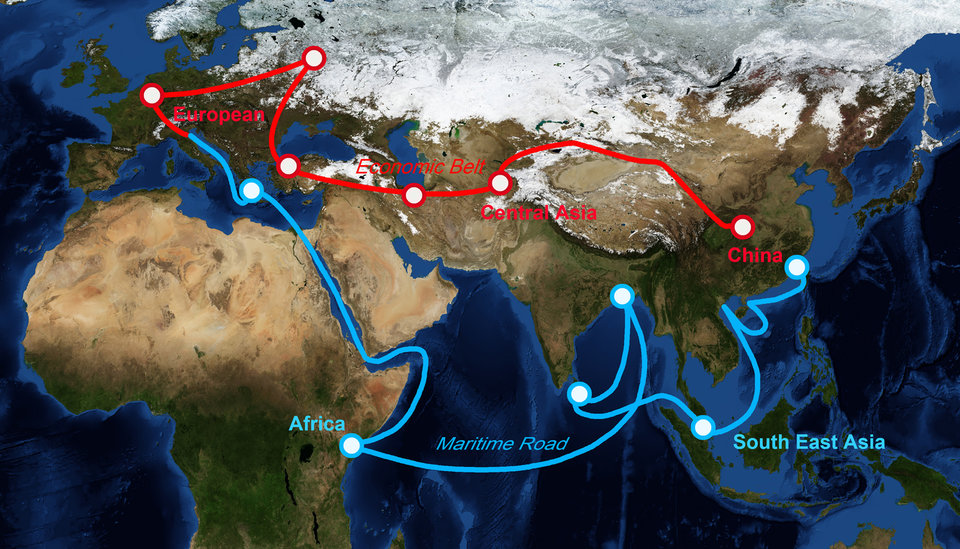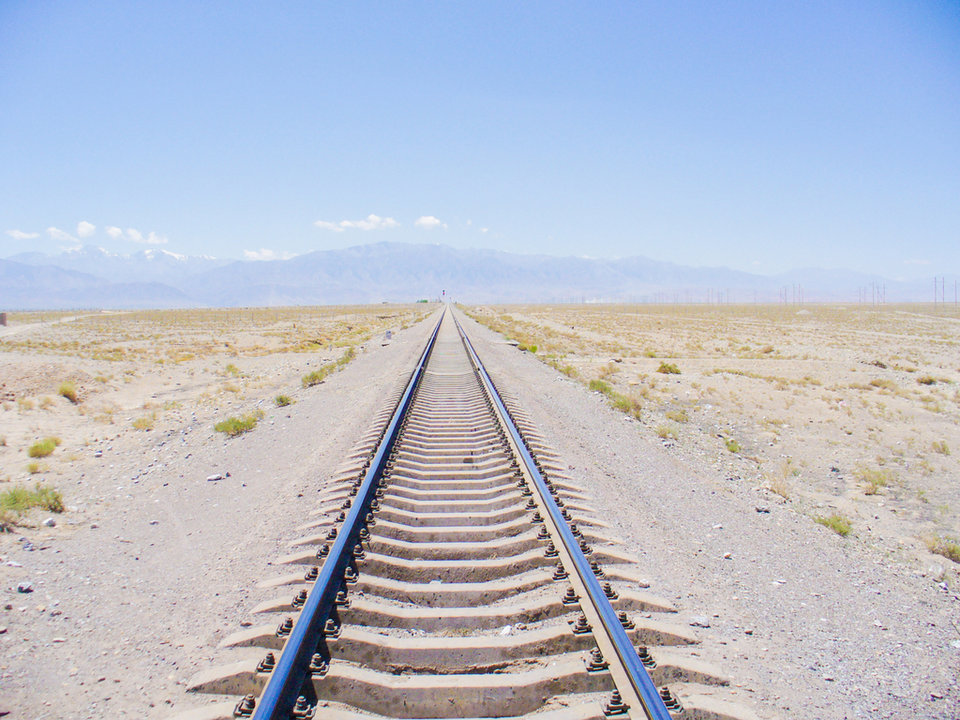The speed of trains between China and Europe is heavily dependent on the railway infrastructure and country-specific guidelines along the routes
The Silk Road
The China-Germany freight route stretches 9,400km. Starting in Xi’an in China, the service heads to Kazakhstan, then through Russia, onto Belarus and Lithuania, into Poland, before arriving in Hamburg and then Neuss in Germany.
This route also has historical significance as it runs on what used to be the Silk Road. This ancient pathway was used for trade between the Roman Empire and China. For hundreds of years, civilisations traded items such as spices, precious stones and fabrics (one of which was obviously silk). However, the route was dealt a fatal blow by the Ottoman Empire, which stopped trade that went through Turkey in the 15th century.

A map showing the principal routes along China’s ‘One Belt One Road’ initiative.
These days, camels have been ditched in favour of trains and tracks. With the ‘New Silk Road’, faster services are intended to give customers a competitive edge in the supply chain.
“The transit time savings of 35%-40% compared to other existing rail services enables the customers to reduce their stocks and get their products faster to the end-customer,” adds Vikas Saxena.
Around a week is knocked off the travel time through a combination of taking a more direct route and improved efficiency in handling operations, as well as other processing areas.
“The short transit time is achieved based on the amalgamation of various factors. Apart from using the new routing, we also ensure more efficient and faster handling at various border points,” says Vikas Saxena. “The speed of trains between China and Europe is heavily dependent on the railway infrastructure and country-specific guidelines along the routes. However, we are continuously looking at ways, whether through enhancing operational efficiency or new routes, to reduce transit times.
“We are constantly looking at ways to develop more efficient services to cater to our customers’ requirements and will be happy to share more when the details are available.”
According to DHL, numerous industries will benefit from faster transit times.
“All industries will stand to benefit from the fast rail service. Companies from the automotive, electronics, telecommunications, retail and consumer, and engineering and manufacturing sectors will particularly derive high benefits by using this service,” adds Vikas Saxena.
Coping with increasing volume
In order to handle this increased volume, DHL Global Forwarding has established three strategically placed Rail Competence Centres across Europe staffed by experts in Chinese rail, who can offer specialist advice and help to provide effective freight management. The centres are located in Felixstowe in the UK, Le Havre in France, and Genoa in Italy.
Teams manage high-volumes of imports and exports, overseeing the entire transit process from beginning to end, including customs clearances and final delivery.
An innovation on the Xi’an-Germany route is that customers can track a shipment in real-time with GPS through the iSee app to view its progress and find out exactly where it is on the route. Temperature readings can also be provided for certain shipments.
In an era where fewer flights are encouraged, rail freight presents a more eco-friendly option and offers lower carbon emissions than other modes of transport. Furthermore, rail routes have the additional advantage of often going directly into city centres, avoiding the potential delays with customs checks and capacity that can sometimes occur at ports and airports.
It is hoped that the China-Germany rail route will become the freight service option of choice for multiple businesses operating both in Europe and China.
In an era where fewer flights are encouraged, rail freight presents a more eco-friendly option
China’s Silk Road fund has set aside around $40bn to invest in countries identified in the project
China’s Belt and Road plan
The New Silk Road project is part of the Chinese Government’s wider ‘Belt and Road’ initiative that was launched in 2013. This hugely ambitious plan aims to boost domestic trade in China by a staggering $2.5tn in ten years through an almost complete restoration of the Silk Road.
‘Belt’ refers to the rail services operating between China and continental Europe as part of the New Silk Road. While the ‘Road’ aspect actually relates to shipping routes that also connects China and Europe with ports in Africa and India.

A railway track on the Silk road in Gansu, China.
To get an idea of the scale of the project, it involves investments in 152 countries. China’s Silk Road fund has set aside around $40bn to invest in countries identified in the project. And investment will be vital, as not all the infrastructure in some of these nations is as up to date as others. For example, any dilapidated railway tracks could affect the smoothness and efficiency of wider services.
One possible hindrance to such an enormous project is geopolitical tensions. In an ever-more unpredictable world, cooperation between nations will be essential. If one country on the route is opposed to the project, it could cause significant disruption and have a negative financial impact.
That said, trade deals have a history of easing such tensions. If the Belt and Build initiative is successful, it has the potential to transform the global freight industry as we know it. And logistics firms such as DHL will have a key role to play in this.